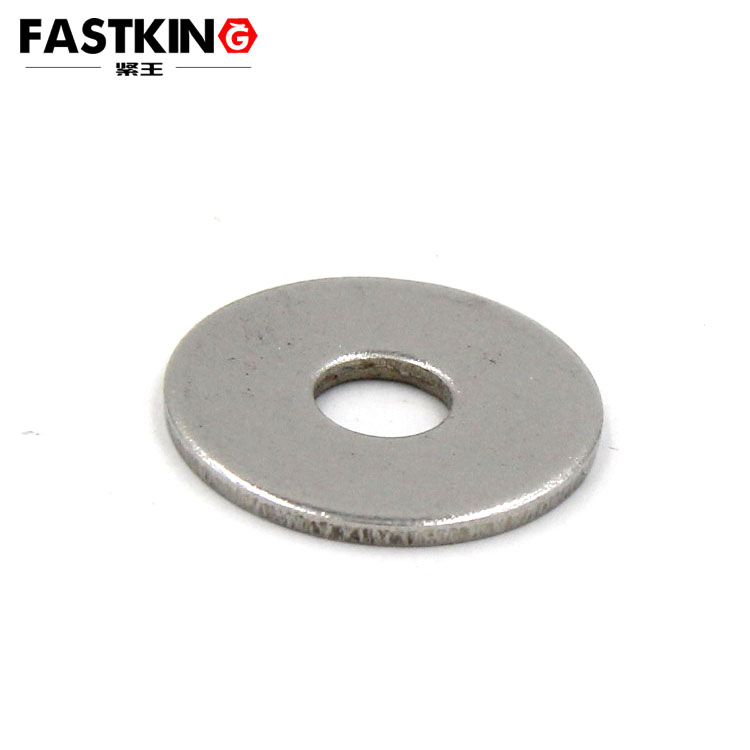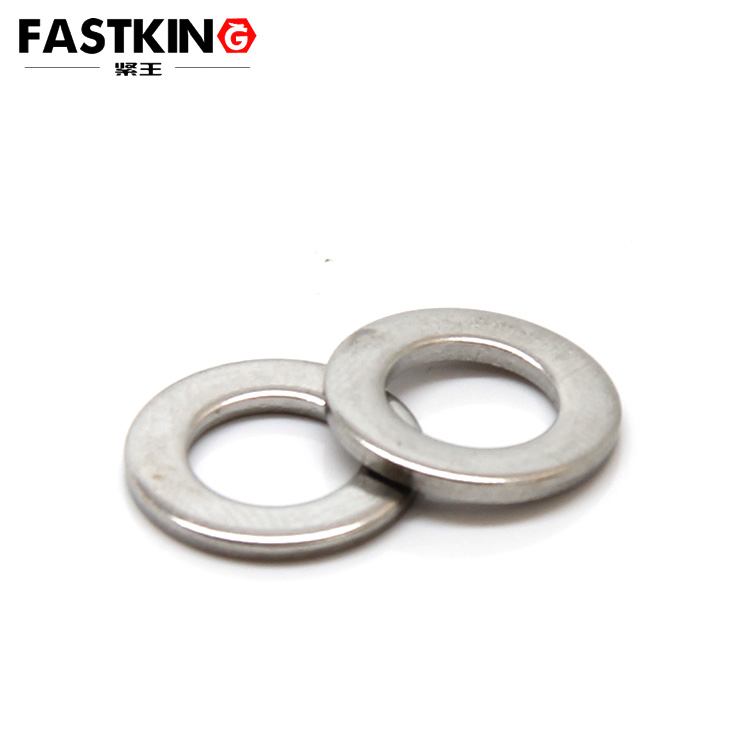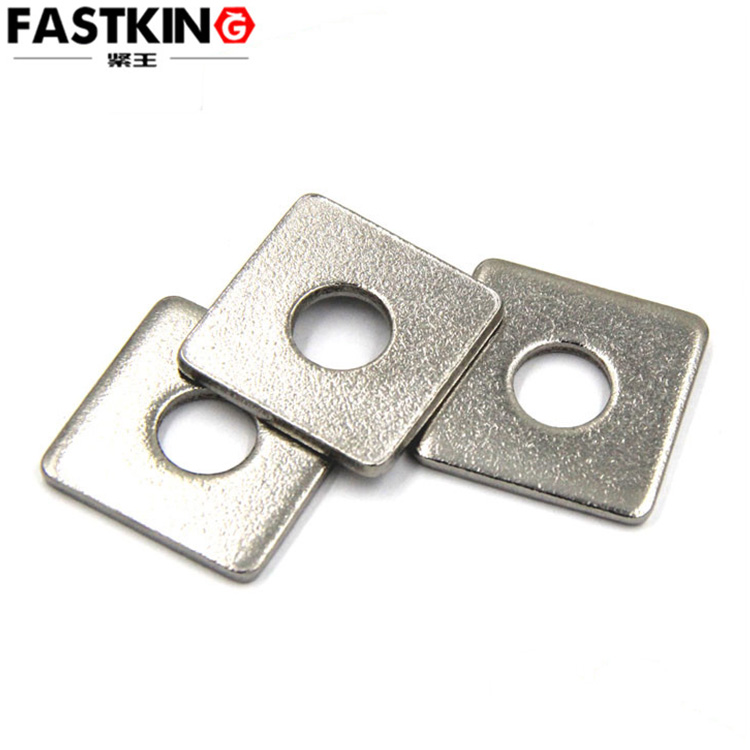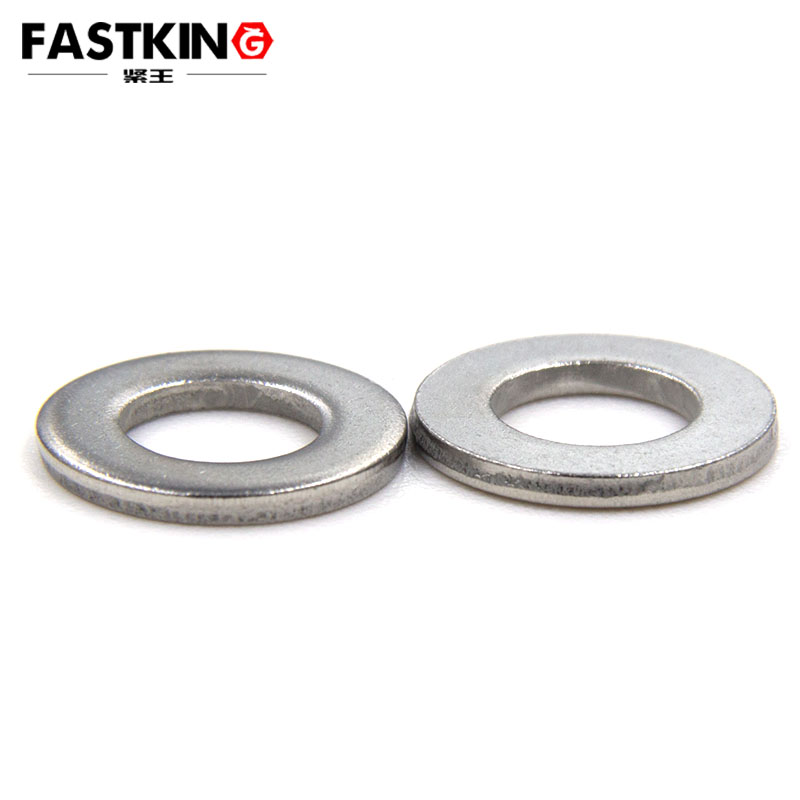- ZHUHAI JIALI HARDWARE CO.,LTD.
- +86-756-8586520
Flat washer
- Product description:A flat washer is a thin component with a hole in the center, primarily used for distributing pressure, reducing friction, preventing leakage, and isolating fasteners. By increasing the bearing surface
In the fastening system composed of threaded fasteners such as bolts and nuts, flat washers may seem like "unremarkable thin components", but they play a crucial "connecting" role. As core auxiliary components for reducing friction, distributing pressure, and protecting the surface of connected parts, standard flat washers have formed unified standards based on the specifications of different countries and regions. Among them, DIN125 (German Industrial Standard) and GB97 (Chinese National Standard) are the most commonly used. Although these two types of flat washers share the same core functions, they slightly differ in dimensional accuracy and application scenarios, jointly safeguarding the fastening reliability in fields such as mechanical manufacturing, construction and installation, and electronic equipment.
I. Product Definition: The "Protector" and "Buffer" of the Fastening System
A flat washer is essentially a circular or irregular thin sheet component, with a thickness typically ranging from 0.5mm to 10mm (adjusted according to specifications), and a through-hole in the center that matches the rod diameter of bolts or screws. Its core function stems from the "inherent limitation" of threaded fasteners—bolts, nuts, and other fasteners have a small bearing surface area (for example, the diameter of the bearing surface of an M10 bolt head is approximately 15mm). If they directly contact connected parts (such as thin metal plates, plastic parts, or wood), the compressive stress generated during fastening will concentrate in a small area, easily causing the surface of the connected part to dent, deform, or even crack. However, by increasing the contact area, flat washers evenly distribute the pressure of the fastener onto the surface of the connected part, acting like a "buffer pad" between the two. This not only protects the appearance and structural integrity of the connected part but also prevents the fastener from loosening due to excessive local stress.
In addition, flat washers also have multiple auxiliary functions: in vibrating environments, washers can reduce friction between fasteners and connected parts, lowering the risk of loosening caused by vibration; in sealing scenarios (such as pipeline connections), metal flat washers or flat washers with a sealing coating can fill tiny gaps on the contact surface to prevent fluid leakage; when assembling connected parts of different materials (such as steel bolts and aluminum alloy plates), washers can isolate the two metals, avoiding electrochemical corrosion and extending the service life of the entire fastening system. These functions elevate flat washers from "auxiliary components" to "an indispensable part of the fastening system".
II. Standard Specifications: Differences and Commonalities Between DIN125 and GB97
As two widely recognized international standards for flat washers, DIN125 (German Industrial Standard) and GB97 (Chinese National Standard) share similarities in technical requirements while also having detailed differences. Users need to select the appropriate standard based on the application scenario and regional specifications.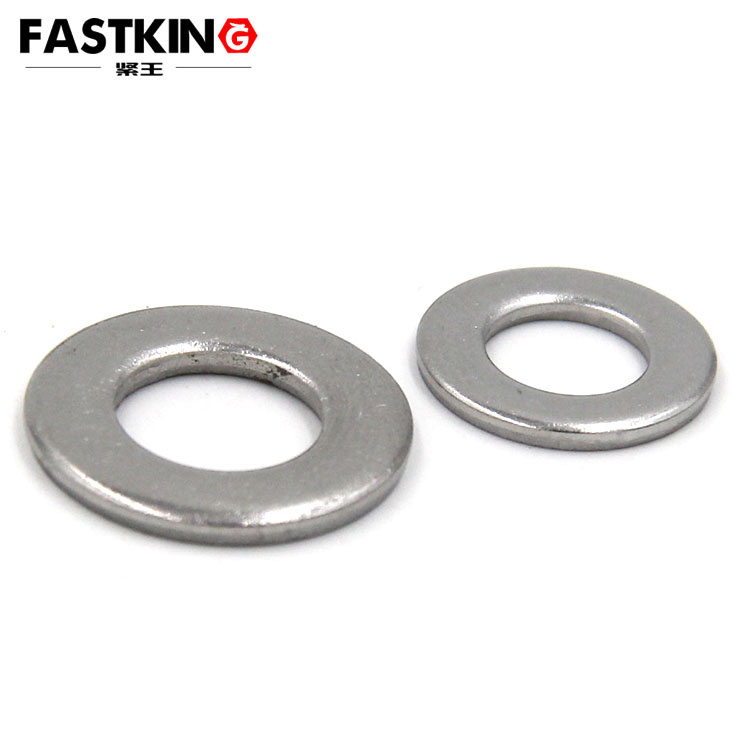

1. Commonalities: Standardization of Core Parameters
Both standards classify specifications based on the "nominal diameter of bolts" (common specifications range from M1.6 to M64). Key parameters such as washer outer diameter, inner diameter, and thickness have clear numerical requirements to ensure perfect compatibility with fasteners of corresponding specifications. For example, for M8 bolts, both DIN125 and GB97 specify that the inner diameter of the washer is approximately 8.4mm (with an allowable error of ±0.1mm), ensuring the bolt rod can pass through smoothly. Additionally, both standards impose requirements on the mechanical properties of the washer material—for instance, the hardness of ordinary carbon steel washers must be ≤ HB140 to prevent scratching the connected part due to excessive hardness. Furthermore, both standards require the washer surface to be flat, free of burrs, cracks, rust, and other defects, ensuring the effectiveness of the contact area.
2. Differences: Dimensional Accuracy and Application Scenario Focus
Flat washers conforming to DIN125 are divided into "Class A" and "Class C": Class A washers have higher dimensional accuracy (e.g., the outer diameter error of an M8 washer is ±0.3mm) and a surface roughness of ≤ Ra1.6μm, making them suitable for scenarios with high precision requirements such as precision equipment and automobile engines; Class C washers have slightly lower accuracy (outer diameter error of ±0.5mm) and lower cost, and are mostly used in heavy-load scenarios with low precision requirements such as construction steel structures and general machinery.
GB97, on the other hand, is divided into GB97.1 (standard type) and GB97.2 (enlarged type): GB97.1 has dimensions similar to those of DIN125 Class A washers and is suitable for conventional fastening needs; GB97.2 washers have a larger outer diameter (e.g., the outer diameter of an M8 washer is approximately 24mm, 3mm larger than that of GB97.1), providing a larger contact area. They are specifically designed for easily deformable connected parts (such as plastic parts and thin aluminum plates) to further distribute pressure and avoid damage. This classification method is more in line with the "targeted protection" needs of the Chinese market and is widely used in fields such as electronic home appliances and furniture manufacturing.
In addition, regarding surface treatment requirements, DIN125 has stricter requirements for galvanized layer thickness (minimum zinc layer thickness ≥ 5μm), making it suitable for outdoor or humid environments; GB97 allows users to choose surface treatments such as galvanizing, black oxide coating, and phosphating according to their needs, offering greater flexibility and compatibility with different corrosive environments.
III. Core Functions: Four Major Roles Ensuring Fastening Reliability
The value of flat washers is reflected through four core functions, which cooperate with each other in practical applications to form a complete "protection system":
1. Distributing Pressure and Protecting Connected Parts
This is the most core function of flat washers. Take furniture assembly as an example: if an M6 bolt is used to directly fix a solid wood board, the compressive stress on the bolt head will concentrate in an area with a diameter of approximately 12mm. During tightening, this easily causes the wood fibers to break and leaves an "indentation"; however, after installing a GB97.1 M6 flat washer (with an outer diameter of approximately 14mm), the pressure distribution area increases by about 30%, and only a slight indentation appears on the wood surface. This not only ensures fastening strength but also protects the furniture's appearance. In automobile body assembly, if thin steel plates (thickness ≤ 1mm) directly contact bolts, they are prone to deformation due to concentrated pressure. The addition of flat washers can distribute the pressure to a larger area, ensuring the flatness of the car body structure.

2. Reducing Friction and Preventing Loosening
In scenarios with frequent vibrations (such as motors and water pumps), the friction between fasteners and connected parts gradually decreases with vibration, leading to bolt loosening. Flat washers have a low surface roughness (usually ≤ Ra3.2μm), which can reduce changes in the friction coefficient between the two. At the same time, the elasticity of the washer itself (e.g., when a spring washer is used with a flat washer) can absorb part of the vibration energy, reducing the risk of loosening. For example, if no flat washer is installed on the fixing bolts of a motor end cover, the loosening probability is approximately 20% after 3-6 months of operation; after installing a flat washer, the loosening probability can be reduced to less than 5%.
3. Isolating Materials and Preventing Corrosion
When fasteners and connected parts are made of different materials (such as stainless steel bolts and carbon steel plates), their contact forms an "electrochemical cell", which is prone to electrochemical corrosion in humid environments, causing bolts to seize or plates to rust. Flat washers can act as an "isolation layer" to avoid direct contact between the two metals. For example, in marine engineering equipment, installing a stainless steel flat washer (conforming to DIN125 Class A) between a galvanized carbon steel bolt and an aluminum alloy bracket can effectively block the electrochemical corrosion path and extend the service life of the equipment by 3-5 years.
4. Filling Gaps and Preventing Leakage
In the connection of fluid conveying equipment such as pipelines and valves, there may be tiny gaps (≤ 0.1mm) between fasteners and flange surfaces, which easily lead to fluid leakage. In such cases, selecting flat washers with a copper coating or rubber interlayer (e.g., DIN125 Class C carbon steel washers coated with a 0.1mm thick copper layer) allows the washer to slightly deform under pressure, filling the gaps and forming a sealing effect. In tap water pipeline connections, such coated flat washers can control the leakage rate to below 0.01L/h, far lower than the 0.5L/h leakage rate of connections without washers.
IV. Material Selection: "Customized Solutions" for Different Environments
The material selection of flat washers needs to be comprehensively determined based on the service environment, load requirements, and cost budget. Common materials are divided into two categories: metal and non-metal.
1. Metal Materials: Suitable for Heavy Loads and Harsh Environments
- Ordinary Carbon Steel: Such as Q235 steel, which has low cost and high strength (tensile strength ≥ 375MPa). It is suitable for heavy-load connections in dry indoor environments (such as construction steel structures and mechanical equipment bases) and usually requires galvanizing or black oxide coating for rust prevention.
- Stainless Steel: Such as 304 stainless steel (a common material for DIN125 Class A washers), which has excellent acid, alkali, and salt spray resistance. It is suitable for outdoor, marine, and chemical environments (such as photovoltaic brackets and marine equipment), requires no additional rust prevention treatment, and has a long service life but higher cost.
- Copper Alloys: Such as brass and red copper, which have good electrical conductivity and soft texture. They are suitable for electronic equipment (such as circuit board fixing) or sealing scenarios (such as pipeline connections). They can fill gaps through deformation while avoiding scratches on precision components.
2. Non-Metal Materials: Suitable for Light Loads and Protection Needs
- Plastics: Such as nylon 66 and polytetrafluoroethylene (PTFE), which are lightweight, have good insulation properties, and are non-corrosive. They are suitable for the interior of electronic equipment (such as computer case screws) or non-metal connected parts (such as plastic casings), and can avoid the impact of metal washers on insulation performance.
- Rubber: Such as nitrile rubber and silicone rubber, which have good elasticity and sealing properties. They are specifically used in sealing scenarios (such as faucets and valves) but have low load-bearing capacity and are only suitable for light-load fastening.
V. Application Scenarios: Comprehensive Coverage from Industry to Daily Life
The application scenarios of standard flat washers (DIN125 and GB97) cover almost all fields requiring threaded fastening, focusing on three types of scenarios:
1. Industrial Manufacturing Field
In heavy industries such as automobile manufacturing, machinery, and aerospace, flat washers are "standard components". For example, the M12 bolt connections of automobile chassis need to be matched with DIN125 Class C carbon steel flat washers to distribute the pressure generated by chassis vibration and avoid deformation of the thin steel plates of the frame; the flange connections of wind power equipment use GB97.2 stainless steel flat washers, which utilize their large outer diameter to distribute the radial load during wind turbine operation while resisting outdoor sand, wind, and rain erosion.
2. Electronic and Home Appliance Field
In products such as mobile phones, computers, and air conditioners, flat washers are mostly small-sized (such as M2-M5) and are mainly made of stainless steel or nylon. For example, the fixing screws of computer motherboards need to be matched with GB97.1 nylon flat washers, which not only isolate metal screws from the circuit board to prevent short circuits but also avoid solder joint detachment caused by direct contact between screws and the circuit board; the casing connections of outdoor air conditioning units use galvanized carbon steel flat washers to reduce vibration friction and prevent loosening of the casing screws.
3. Construction and Home Furnishing Field
In construction and decoration (such as ceiling keels and curtain wall installation) and home furnishing assembly (such as wardrobes and tables and chairs), flat washers are key to protecting materials. For example, if M6 self-tapping screws for ceiling keels are directly screwed into gypsum boards, the gypsum boards are prone to cracking; after installing GB97.1 flat washers, the pressure is distributed to a larger area, increasing the integrity rate of gypsum boards by 90%; in the connection of solid wood furniture, brass flat washers can avoid direct contact between steel screws and wood, preventing wood discoloration due to electrochemical corrosion.
As the "invisible guardian" of the fastening system, although standard flat washers (DIN125 and GB97) have a simple structure, they have become indispensable basic components in industrial production and daily life due to their core values of "distributing pressure, protecting components, preventing loosening and leakage". Whether choosing the precision type of DIN125 or the targeted protection type of GB97, the key is to match the appropriate standard based on the fastener specifications, the material of the connected part, and the service environment. Only in this way can the role of flat washers be maximized, ensuring that every fastening is stable, reliable, and long-lasting.


